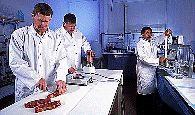United States Department of Agriculture: Agricultural Research Service, Lincoln, Nebraska
Date of this Version
2012
Document Type
Article
Citation
J. Anim. Sci. 2012. 90:1150–1151; http://dx.doi.org/10.2527/jas.2011-5007
Abstract
The Physiology and Endocrinology Symposium on “Factors controlling puberty in beef heifers” was held at the Joint Annual Meeting of the American Society of Animal Science and the American Dairy Science Association in New Orleans, Louisiana, July 10 to 14, 2011. The objective of the symposium was to provide attendees with new insights and perspectives from recent research findings on puberty in beef heifers. To that end, the 2011 physiology and endocrinology symposium program was organized to review recent research findings in beef cattle puberty with a broad overview of areas affecting puberty including management, genetics, nutrition, and hormonal manipulation of the estrous cycle.
Lamb et al. (2011), the first speaker of the symposium, discussed the management implications associated with the onset of puberty and persistence of estrous cycles in beef heifers. Significant costs are associated with development and management of replacement beef heifers; therefore, management strategies that maximize the number of replacement heifers attaining puberty before their first breeding season are vital for the efficiency of cow-calf operations. Lamb et al. (2011) presented data demonstrating that fertility in replacement beef heifers was not compromised by delaying the majority of BW gain until the last third of the developmental period before the onset of the breeding season. Body weight at the onset of the breeding season and BW at puberty were not compromised compared with heifers on a constant rate of BW gain during the developmental period. Furthermore, persistence of estrous cycles after establishment of puberty are affected by dietary energy restriction and repletion but may be activated gradually in response to dietary manipulation unrelated to many metabolite changes.


